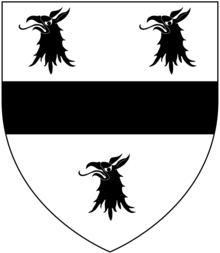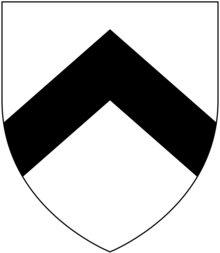Boconnoc is a civil parish in Cornwall, England, United Kingdom, approximately four miles (6 km) east of the town of Lostwithiel. According to the 2011 census the parish had a population of 96.

Sir Jonathan Trelawny, 2nd Baronet, of Trelawny in the parish of Pelynt in Cornwall, England, was a Cornish Member of Parliament.

Brigadier-General Henry Trelawny was a British Army officer of Cornish descent, a Member of Parliament and Vice-Admiral of Cornwall.

Roborough is a village and civil parish 5.5 mi (8.9 km) from Great Torrington, in Devon, England. Situated topographically on the plateau between the Torridge and Taw Rivers, the parish covers 1,258 ha and contains a population of some 258 parishioners. It is surrounded by a pastoral landscape of rectangular fields, high hedges and scattered farmsteads.

Sydenham House in the parish of Marystow in Devon, England, is a seventeenth-century manor house. The Grade I listed building is situated about thirteen miles south-west of Okehampton, on a 1,200 acres (490 ha) estate. It was built by Sir Thomas Wise (d.1629) between 1600 and 1612, incorporating an older structure. It was partially destroyed by fire in 2012. The gardens are Grade II listed in the National Register of Historic Parks and Gardens.

Sir Thomas Grenville II, K.B.,, lord of the manors of Stowe in Kilkhampton, Cornwall and Bideford, Devon, Sheriff of Cornwall in 1481 and 1486. During the Wars of the Roses, he was a Lancastrian supporter who had taken part in the conspiracy against Richard III, organised by the Duke of Buckingham. On the accession of King Henry VII (1485–1509) to the throne, Sir Thomas was appointed one of the Esquires of the Body to Henry VII. On 14 November 1501 upon the marriage of Prince Arthur to Katherine of Aragon, he was created a Knight of the Bath. He served on the Commission of the Peace for Devon from 1510 to his death in circa 1513.

The landed gentry and nobility of Devonshire, like the rest of the English and European gentry, bore heraldic arms from the start of the age of heraldry circa 1200–1215. The fashion for the display of heraldry ceased about the end of the Victorian era (1901) by which time most of the ancient arms-bearing families of Devonshire had died out, moved away or parted with their landed estates.
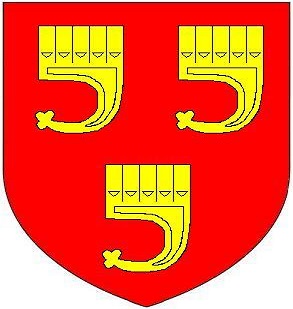
The manor of Bideford in North Devon was held by the Grenville family between the 12th and 18th centuries. The full descent is as follows:

Warleigh is an historic estate within the parish of Bickleigh in Devon, about 6 miles from Plymouth. Warleigh House, the manor house of the manor of Tamerton Foliot is situated one mile west of that village on the south-east bank of the River Tavy where it joins the River Tamar. It was remodelled in about 1830 in the Gothic style by John Foulston and has been listed Grade II* on the National Heritage List for England since 1960.
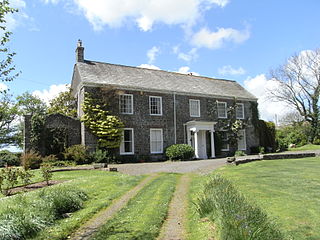
Thuborough in the parish of Sutcombe, Devon, England, is an historic estate, formerly a seat of a branch of the Prideaux family, also seated at Orcharton, Modbury; Adeston, Holbeton; Soldon, Holsworthy; Netherton, Farway; Ashburton; Nutwell, Woodbury; Ford Abbey, Thorncombe, all in Devon and at Prideaux Place, Padstow and Prideaux Castle, Luxulyan, in Cornwall. The present mansion house, comprising "Thuborough House" and "Thuborough Barton", the north-east block, is a grade II listed building.
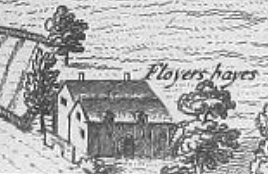
Floyer Hayes was an historic manor in the parish of St Thomas on the southern side of the City of Exeter in Devon, England, from which city it is separated by the River Exe. It took its name from the ancient family of Floyer which held it until the early 17th century, when it was sold to the Gould family. In the 19th century the estate was divided up and the manor house demolished. The parish church of St Thomas, situated a short distance to the west of the house, was burned down in 1645 during the Civil War, and was rebuilt before 1657. Thus no monuments survive there of early lords of the manor, namely the Floyer family.
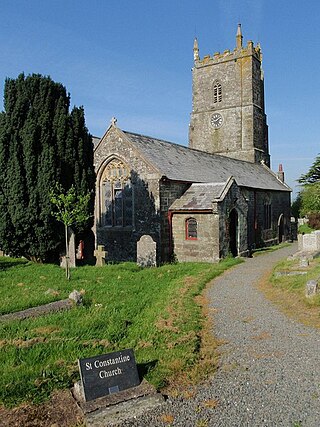
Milton Abbot is a village, parish, and former manor in Devon, 6 miles (9.7 km) north-west of Tavistock, Devon, and 6 miles (9.7 km) south-east of Launceston, Cornwall.
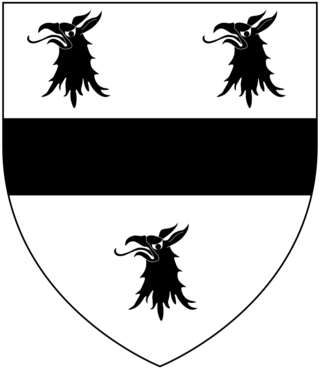
Kenedon is an historic manor situated in the parish of Sherford in Devon.

South Milton is a village and civil parish in the South Hams district, in the county of Devon, England, situated on the south coast about 2 miles south-west of Kingsbridge. The civil parish includes the hamlets of Sutton, south of the village, and Upton, north of the village. In 2021 the parish had a population of 371.
Collacombe is an historic manor in the parish of Lamerton, Devon, England. The manor house survives as a grade I listed building, known as Collacombe Barton or Collacombe Manor (House).
The manor of Broad Hempston was a historic manor situated in Devon, England, about 4 miles north of Totnes. The present village known as Broadhempston was the chief settlement within the manor and remains the location of the ancient parish church of St Peter and St Paul.

Hareston is an historic estate in the parish of Brixton, about three miles from Plymouth in Devon. The mansion house built during the reign of King Henry VII (1485-1509) burned down partially in an accidental fire at the beginning of the 18th century, and in 1822 the surviving part, the Hall and Chapel, was being used as a farmhouse. It was described by Candida Lycett Green in her 1991 book The Perfect English Country House as: "The most forgotten Manor House Farm In England, untouched for hundreds of years, sits safely, impossible to find, down miles of private sunken lanes which in the spring brim with Campion, Bluebells, Purple Orchids, Primroses, Violets, Speedwell and Stitchwort. Wooded hills rise behind this, the quintessence of an ancient English Manor House".

Spridleston is an historic manor in the parish of Brixton in Devon, England, long a seat of a branch of the prominent and widespread Fortescue family. The ancient manor house does not survive, but it is believed to have occupied the site of the present Spriddlestone Barton, a small Georgian stuccoed house a few hundred yards from the larger Spriddlestone House, also a Georgian stuccoed house, both centred on the hamlet of Spriddlestone and near Higher Spriddlestone Farm.
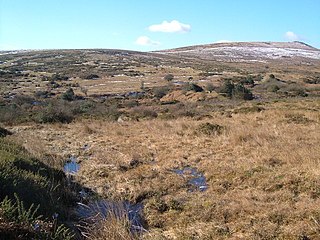
Bagtor is a historic estate in the parish of Ilsington in Devon, England. It was the birthplace of John Ford the playwright and poet. The Elizabethan mansion of the Ford family survives today at Bagtor as the service wing of a later house appended in about 1700.

John Woolcombe (1680–1713) of Pitton in the parish of Yealmpton in Devon, was a Member of Parliament for Plymouth in Devon 1702–5, and served as Sheriff of Devon in 1711–12.



